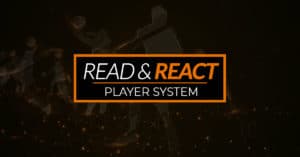Perimeter and Post Actions
Clip 1: This clip begins with #2 Kamille making a Basket Cut because she is one pass away and her defender is over the Read Line (Pass & Cut Layer).
#21 Kachine Passes and Cuts, looking for a scoring opportunity (Pass & Cut Layer).
#20 Kelly Krei must fill two empty spots toward the ball (Pass & Cut Layer) – see the blue arrow.
But while Kelly is filling, the ball is driven in the opposite direction – to the left – by #24 Jaime. Because of the North-South Drive Circle Movement Layer, Kelly must immediately change directions (double blue arrows).
The combination of these two simple layers makes it very tough on Kelly’s defender: She must move from weak-side help position to ball-side denial and make the decision whether or not to help on the drive while Kelly is changing directions. For defenders in this situation – there’s too much movement, too much space, too many decisions and just not enough time to close out.
Clip 2: I like this clip because it demonstrates that unselfishness with the ball in the Read & React means that you increase your own scoring opportunities. #2 Kamille passes to the wing and makes a Basket Cut. This is her first scoring opportunity – a reward for sharing the ball. She’s not open this time, so she fills out to the opposite wing.
#21 Kachine attempts the same action (Pass & Cut Layer) and I think she’s open with her Front Cut, but the passer misses her. At this time, #24 Jaime decides to drive left. #2 Kamille must Circle left and become her Safety Valve (blue arrows left).
However, #24 Jaime immediately changes direction with her move.
I get this question all of the time: What do the perimeter players do when the ball handler changes directions like this?
The answer is simple: Once the Read & React has reached the “I don’t have to think, I only react by habit” stage (and this is Goal #1 with the Read & React), the perimeter players change directions the split second that the ball changes directions. When Jaime changes directions, Kamille changes directions.
Note the predicament of Kamille’s defender: she steps toward the ball to help (just like any good defender is supposed to do), but Circle Movement has created a change of direction and too much space for the defender to recover. Circle Movement also creates a clean passing window for the Draw & Kick.
Here’s a beautiful dynamic that you get with the Read & React: #2 Kamille initiated this action by giving up the ball. In return, she’s the one who was able to shoot the open 3 pointer. If Kamille had not shared the ball, she would not have gotten this clean look at the goal.
And that’s the way basketball is supposed to work in Rick Torbett’s Universe: Share the ball; do it for the sake of your team; and get rewarded with a 3 pointer! All is well in the world…
Clip 3: #21 Kachine Passes and Cuts to the basket while #2 Kamille feeds the post (Pass & Cut Layer). Kachine threatens the basket and must be guarded, so her defender cannot help in the post.
#2 Kamille decides to X-CUT after feeding the post (Post Passing Layer). The defense must guard #20 Kelly Krei off the X-CUT Screen while at the same time guarding #2 Kamille cutting to the basket after she sets the X-CUT Screen.
With the defense occupied, #12 Morgan can make her move cleanly in the post, unhindered by help defense.
My question for the non-Read-&-React basketball community: “Why would you ever feed the post and stand?” We all know what players should do, and still, on all levels, I see feed the post and stand. The defense can turn most of its attention to the post and help, double-team, rotate, etc., when they are guarding statues on the perimeter. This never happens with the Read & React. If it does, you’re not running the Read & React!
Clip 4: Another question I get a lot is: “Where are ball-screens in the Read & React?”
My answer: Anywhere and anytime you want.
The ball-screen might be a planned call by the coach with a specific player in a specific situation at a specific time. Or, if your team has advanced to Iowa’s level, the ball-screen can be set whenever the players see a good opportunity. That is the case in this clip.
Remember, the only thing Post Players are required to do is react correctly to Dribble Penetration (Basic Post Slide Layer and Advanced Post Slide Layer). Otherwise, you the coach, can do anything you want to do with your post player(s).
You could run the offense through your post; you could work a High-Low game; your post could be a screener for cutters, your post could screen on the ball; you could play the post up high, mid-post, or short corner; your post could go inside and outside if their skills allowed it, etc. Regardless of how you play your post(s), the Read & React will remain intact and coordinated. Changing how your post(s) play simply changes the type of action and scoring opportunities created.






